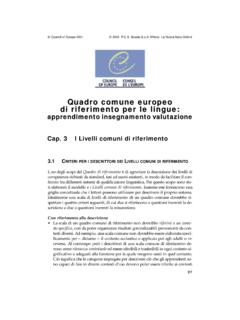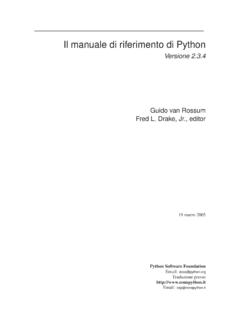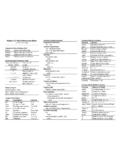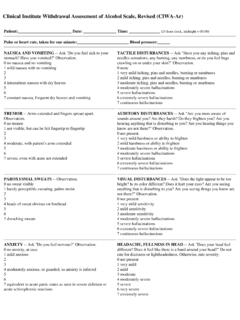Transcription of MEASUREMENT SYSTEMS ANALYSIS - Ruby …
1 I MEASUREMENT SYSTEMS ANALYSIS Reference Manual Fourth Edition First Edition, October 1990 Second Edition, February 1995; Second Printing, June 1998 Third Edition, March 2002; Second Printing, May 2003; Fourth Edition, June 2010 Copyright 1990, 1995, 2002, 2010 Chrysler Group LLC, Ford Motor Company, General Motors Corporation ISBN#: 978-1-60-534211-5 ii iiiFOREWORD This Reference Manual was developed by a MEASUREMENT SYSTEMS ANALYSIS (MSA) Work Group, sanctioned by the Chrysler Group LLC, Ford Motor Company, and General Motors Corporation Supplier Quality Requirements Task Force, and under the auspices of the Automotive Industry Action Group (AIAG). The Work Group responsible for this Fourth Edition were Michael Down (General Motors Corporation), Frederick Czubak (Chrysler Group LLC), Gregory Gruska (Omnex), Steve Stahley (Cummins, Inc.)
2 And David Benham. The manual is an introduction to MEASUREMENT system ANALYSIS . It is not intended to limit evolution of ANALYSIS methods suited to particular processes or commodities. While these guidelines are intended to cover normally occurring MEASUREMENT system situations, there will be questions that arise. These questions should be directed to your authorized customer representative. This Manual is copyrighted by Chrysler Group LLC, Ford Motor Company, and General Motors Corporation, with all rights reserved, 2010. Additional manuals can be ordered from AIAG at Permission to reproduce portions of this manual for use within supplier organizations may be obtained from AIAG at June 2010 iv MSA 4th Edition Quick Guide Type of MEASUREMENT System MSA Methods Chapter Basic Variable Range, Average & Range, ANOVA, Bias, Linearity, Control Charts III Basic Attribute Signal Detection, Hypothesis Test Analyses III Non-Replicable ( , Destructive Tests)
3 Alternate Approaches IV Complex Variable Range, Average & Range, ANOVA, Bias Linearity Control Charts III, IV Multiple SYSTEMS , Gages or Test Stands Control Charts ANOVA Regression ANALYSIS III, IV Miscellaneous Alternate Approaches IV Other White Papers available at AIAG website ( ) NOTE: Regarding the use of the GRR standard deviation Historically, by convention, a 99% spread has been used to represent the full spread of MEASUREMENT error, represented by a multiplying factor (where GRR is multiplied by to represent a total spread of 99%).
4 A spread is represented by a multiplier of , which is 3 and represents the full spread of a normal curve. If the reader chooses to increase the coverage level, or spread, of the total MEASUREMENT variation to , use as a multiplier in place of in the calculations. Note: The approach used in the 4th Edition is to compare standard deviations. This is equivalent to using the multiplier of 6 in the historical approach. Awareness of which multiplying factor is used is crucial to the integrity of the equations and resultant calculations. This is especially important if a comparison is to be made between MEASUREMENT system variability and the tolerance. Consequently, if an approach other than that described in this manual is used, a statement of such must be stated clearly in any results or summaries (particularly those provided to the customer).
5 VTABLE OF CONTENTS MSA 4th Edition Quick TABLE OF CONTENTS ..v List of List of Figures ..viii CHAPTER I General MEASUREMENT System Section A Introduction, Purpose and Terminology ..3 Introduction ..3 Purpose ..4 Terminology ..4 Section B The MEASUREMENT MEASUREMENT SYSTEMS ..13 The Effects of MEASUREMENT System Variability ..18 Section C MEASUREMENT Strategy and Section D MEASUREMENT Source Development ..29 Gage Source Selection Section E MEASUREMENT Issues ..41 Section F MEASUREMENT Section G MEASUREMENT Problem ANALYSIS ..65 CHAPTER II General Concepts for Assessing MEASUREMENT SYSTEMS ..67 Section A Section B Selecting/Developing Test Section C Preparation for a MEASUREMENT System Study ..73 Section D ANALYSIS of the CHAPTER III Recommended Practices for Replicable MEASUREMENT SYSTEMS .
6 81 Section A Example Test Section B Variable MEASUREMENT System Study Guidelines ..85 Guidelines for Determining Guidelines for Determining BiasPF Independent Sample Method ..87 Guidelines for Determining Bias Control Chart Method ..92 Guidelines for Determining Guidelines for Determining Repeatability and Range Average and Range Method ..103 ANALYSIS of Variance (ANOVA) Method ..123 Section C Attribute MEASUREMENT SYSTEMS Study ..131 Risk ANALYSIS Methods ..131 Signal Detection Analytic CHAPTER IV Other MEASUREMENT Concepts and Practices ..151 Section A Practices for Non-Replicable MEASUREMENT SYSTEMS ..153 Destructive MEASUREMENT SYSTEMS ..153 SYSTEMS where the part changes on use/test ..153 Section B Stability Studies ..155 Section C Variability Section D Recognizing the Effect of Excessive Within-Part Section E Average and Range Method Additional Section F Gage Performance Section G Reducing Variation Through Multiple Readings.
7 183 Section H Pooled Standard Deviation Approach to viAppendix ANALYSIS of Variance Appendix Impact of GRR on the Capability Index Formulas: ..199 ANALYSIS : ..199 Graphical ANALYSIS ..201 Appendix Appendix Gage R Appendix Alternate PV Calculation Using Error Correction Appendix F ..209 Error Model ..209 Glossary ..213 Reference List ..219 Sample Forms ..223 Index ..227 viiList of Tables Table I-B1: Control Philosophy and Driving Interest ..18 Table II-D 1: GRR Table III-B 1: Bias Study Table III-B 2: Bias Study ANALYSIS of Bias Study Table III-B 3: Bias Study ANALYSIS of Stability Study for Table III-B 4: Linearity Study Data ..99 Table III-B 5: Linearity Study Intermediate Results ..99 Table III-B 6: Gage Study (Range Method).
8 103 Table III-B 6a: Gage Repeatability and Reproducibility Data Collection Sheet ..105 Table III-B 7: ANOVA Table ..127 Table III-B 8: ANOVA ANALYSIS % Variation & Contribution ..127 Table III-B 9: Comparison of ANOVA and Average and Range Methods ..129 Table III-B 10: GRR ANOVA Method Report ..129 Table III-C 1: Attribute Study Data Table III-C 2: Cross tabulation Study Results ..136 Table III-C 3: Kappa Summary ..137 Table III-C 4: Comparisons of Appraisers to Reference .. 138 Table III-C 5: Study Effectiveness Table III-C 6: Example Effectiveness Criteria Guidelines .. 140 Table III-C 7: Study Effectiveness Summary ..140 Table III-C 8: Table III-C 1 sorted by Ref Table IV-A 1: Methods Based on Type of MEASUREMENT Table IV-H 1: Pooled Standard Deviation ANALYSIS Data Set.
9 189 Table A 1: Estimate of Variance Components ..195 Table A 2: 6 Sigma Spread ..196 Table A 3: ANALYSIS of Variance (ANOVA) ..197 Table A 4: Tabulated ANOVA Results ..198 Table A 5: Tabulated ANOVA Results ..198 Table B 1: Comparison of Observed to Actual Table C 1: *2d Table ..203 Table F 1: Examples of the PISMOEA viiiList of Figures UFigure I-A 1: Example of a Traceability Chain for a Length UFigure I-B 1: MEASUREMENT System Variability Cause and Effect UFigure I-E 2: UFigure I-E 3: Impact of Number of Distinct Categories (ndc) of the Process Distribution on Control and ANALYSIS 47 UFigure I-E 4: Process Control UFigure I-E 5: Characteristics of the MEASUREMENT Process UFigure I-E 6: Relationships between Bias and UFigure III-B 1: Control Chart ANALYSIS for UFigure III-B 2: Bias Study Histogram of Bias UFigure III-B 3: Linearity Study Graphical UFigure III-B 4: Average Chart Stacked UFigure III-B 5: Average Chart Unstacked UFigure III-B 6.
10 Range Chart Stacked UFigure III-B 7: Range Chart Unstacked UFigure III-B 8: Run Chart by UFigure III-B 9: Scatter UFigure III-B 10: Whiskers UFigure III-B 11: Error UFigure III-B 12: Normalized UFigure III-B 13: X Y Plot of Averages by UFigure III-B 14: Comparison X Y UFigure III-B 15: Completed GR&R Data Collection UFigure III-B 16: Gage Repeatability and Reproducibility UFigure III-B 18: Residual UFigure III-C 1: Example Process with Pp = Ppk = UFigure III-C 2: The Gray Areas Associated with the MEASUREMENT UFigure III-C 3: Example Process with Pp = Ppk = UFigure III-C 4: Attribute Gage Performance Curve Plotted on Normal Probability UFigure III-C 5. Attribute Gage Performance UFigure IV-E 1: MEASUREMENT Evaluation Control Chart (T&XRU) - UFigure IV-E 2: MEASUREMENT Evaluation Control Chart (T&XRU) - UFigure IV-E 3: Alternate Computations for Evaluating a MEASUREMENT Process (Part 1 of 2).







